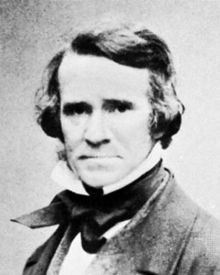Sir John Hawkshaw
| John Hawkshaw | |
|---|---|

John Hawkshaw
|
|
| Born | 9 April 1811 Leeds, Yorkshire |
| Died |
2 June 1891 (aged 80) London |
| Nationality | English |
| Occupation | Engineer |
| Engineering career | |
| Discipline | civil engineer |
| Institutions | Institution of Civil Engineers (president) |
| Projects | London Circle Line |
| Significant design | Suez Canal (inquiry) |
Sir John Hawkshaw FRS FRSE MICE (9 April 1811 – 2 June 1891), was an English civil engineer. He served as President of the Institute of Civil Engineers 1862-63. His most noteworthy work is the Severn Tunnel.
He was born in Leeds, Yorkshire, the son of Henry Hawkshaw, and was educated at Leeds Grammar School. Before he was 21 he had been engaged for six or seven years in railway engineering and the construction of roads in his native county, and in the year of his majority he obtained an appointment as engineer to the Bolivar Mining Association in Venezuela. But the climate there was more than his health could stand, and in 1834 he was obliged to return to England.
He soon obtained employment under Jesse Hartley at the Liverpool docks, and subsequently was made engineer in charge of the railway and navigation works of the Manchester, Bolton and Bury Canal Company. In 1845 he became chief engineer to the Manchester and Leeds Railway, and in 1847 to its successor, the Lancashire and Yorkshire Railway for which he constructed a large number of branch lines. One such was the Manchester and Southport line surveyed by his associate Clement Wilks and as well as the Lancashire and Yorkshire Railway near Heckmondwike. In 1850 he moved to London and began to practise as a consulting engineer, at first alone, but subsequently in partnership with Harrison Hayter. In that capacity his work was of an extremely varied nature, embracing almost every branch of engineering.
He retained his connection with the Lancashire & Yorkshire Company until his retirement from professional work in 1888, and was consulted on all the important engineering points that affected it in that long period. In London he was responsible for the Charing Cross and Cannon Street railways, together with the two bridges which carried them over the Thames; he was engineer of the East London railway, which passes under the Thames through Sir Marc Brunel's well-known tunnel; and jointly with Sir J Wolfe-Barry he constructed the section of the Underground railway which completed the inner circle between the Aldgate and Mansion House stations.
...
Wikipedia
